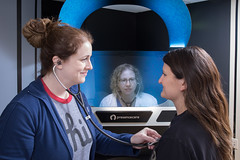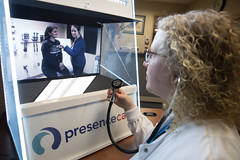Today we welcome Susan Neale, senior writer and editor for The Ohio State University College of Nursing. She explores a non-traditional approach to teaching remote nursing students the nuanced skills and tools needed to succeed in the field. Telehealth technology allows nursing students to gain experience with “patients” remotely, and students are prepared to provide telehealth in the future, working with Ohio State’s unique telehealth clinic. It’s exciting what this innovative teaching modality might mean for future nursing students. Enjoy!
-Erin Walton, contract editor for WCET
Telehealth – the use of communication technologies to provide healthcare services remotely – offers both patient convenience and a promising solution to the crisis of limited healthcare access in Health Professional Shortage Areas (HPSAs) across the United States.  Its use is spreading widely and, at The Ohio State University College of Nursing, we teach telehealth techniques across our curriculum, both on campus and online.
Its use is spreading widely and, at The Ohio State University College of Nursing, we teach telehealth techniques across our curriculum, both on campus and online.
Telehealth education originally got its start at our college as part of our online teaching. We needed a way to evaluate the clinical skills of our online students and thought, “Why not do this as a video conference?” Once we began videoconferencing with online students and actively evaluating their ability to provide care, we quickly transitioned to, “Why don’t we teach them telehealth?” Then, Optimized Care Network (OCN) donated telehealth kiosks to our program, and we decided to not only teach telehealth, but to actively practice it. Now we have our own telehealth clinic as well.
[youtube https://www.youtube.com/watch?v=EFcllvbf5mo]
The big questions
Alice Teall, DNP, APRN-CNP, FAANP, assistant professor in the College of Nursing, says that for her, the big question in designing telehealth education was how to evaluate her students’ ability and readiness to provide telehealth care. To do that, we had to reimagine methods and tools to measure and assess student learning and performance with telehealth. We had to create online learning environments for simulating care by telehealth and create a team of faculty, clinicians, and instructional designers to expand nursing student opportunities to learn telehealth across on-campus programs.
Tools of the trade
We use “standardized patients” – actors hired to role-play as patients – to create videos and livecasts of patient situations. Using web conferencing, a standardized patient can appear onscreen in classrooms online or on campus. The “patient” can then speak to each student individually or to groups of students. Standardized patients are trained to act like real patients and may role-play common occurrences such as forgetting important health information or acting surly when in pain, so that nursing students get to experience what it’s like to triage difficult situations.
Our faculty have also made “store and forward” recordings to simulate patient videoconferencing. When students speak remotely with a standardized patient, they might be sent a video of a patient with a problem, such as coughing or a rash. New faculty are brought onboard with our “telehealth toolkit”—everything from methodical checklists and timelines to practical information on how to use the equipment. In addition, we’ve found that it’s important to have state-of-the-art videoconferencing equipment, with no lag time, echo, or distracting sounds.
A closer look at Ohio State’s Lima campus telehealth clinic
In 2018, the College of Nursing opened a telehealth clinic on our Lima campus to provide care to our students, faculty, and staff. The clinic is staffed by a nurse and linked via state-of-the-art telehealth equipment to Total Health & Wellness (THW), a nurse practitioner-led, interprofessional clinic operated by the college and designated as a Federally Qualified Health Center Look Alike. Using Bluetooth technology, a nurse practitioner at THW can assess the heart sounds of a patient who is being examined by a nurse from 100 miles away as clearly as if she were in the room. The nurse at the clinic acts as the nurse practitioner’s hands, performing the exam using Bluetooth-enabled devices such as an otoscope, blood pressure cuff, and stethoscope. Meanwhile, both nurse and patient can see and talk to the nurse practitioner, who appears on a two-way video conferencing screen. Students from Ohio State’s other health sciences colleges, such as medicine, pharmacy and social work, can also be precepted at the clinic.

The Lima telehealth clinic serves as an integral teaching tool. Online students can use software to access the kiosks and connect with a “patient” in the lab. While the online student acts in the role of the nurse practitioner, another student may also be in the role of the nurse, while faculty watch and monitor their accuracy. Standardized patients may role play various healthcare issues ranging from sinus infections to UTIs. Sometimes a real-life pregnant patient is hired to come in to the telehealth station as a standardized patient.
Telehealth etiquette
Feeling comfortable with providing telehealth care requires practice, and our students benefit from lessons we’ve learned along the way. Of equal importance is that we teach students how to make the patient feel most comfortable. For example, as Teall mentions, if you are sitting in front of a camera as the provider and the patient is on the other side of the screen, you have to remember that all that person can see is your head. So, when you start charting or documenting the visit using your computer, it’s important to say, ‘I’m going to turn my head. I’m going to put this into the computer now.’ Otherwise, all the patient sees is the provider no longer looking at him or her. Explaining the moves that you’re making with equipment off-camera helps build patient trust, as does explaining off-camera sounds. Teall also advises that students should introduce any new people who enter the room before they are in plain sight and explain why those people are there.
The telehealth exam station transmits high-def sound and picture, which can take some getting used to. You cannot wear jewelry because clinking sounds can amplify greatly. We’re used to looking at someone’s face to make eye-contact, but if you look at someone’s face on the screen, it will appear as though you’re looking at his or her shirt, so you need to focus up at your webcam. In addition, students at the clinic are taught not to step between the Bluetooth devices and the broadcasting equipment, or to look at the video screen when they should be looking at the patient’s ear.
 When learning to care for patients who are calling in from remote locations, students are taught to ask, “Are you in a secure place? Are you in a place where we can talk confidentially?” Even if the patient can’t talk out loud, a secure conversation may be possible via texting. Practicing scenarios like these can help future healthcare providers keep a level head when treating telehealth patients in emergency situations.
When learning to care for patients who are calling in from remote locations, students are taught to ask, “Are you in a secure place? Are you in a place where we can talk confidentially?” Even if the patient can’t talk out loud, a secure conversation may be possible via texting. Practicing scenarios like these can help future healthcare providers keep a level head when treating telehealth patients in emergency situations.
Thus far, the review of telehealth care at Lima campus is positive. “Patients love it,” Teall says. “I’ve had people who have said, ‘Oh my gosh, this really is like you are sitting right here.’”
It’s exciting to imagine what the future might bring.

Susan Neale
Senior Writer/Editor for The Ohio State University College of Nursing

 Its use is spreading widely and, at
Its use is spreading widely and, at 
 When learning to care for patients who are calling in from remote locations, students are taught to ask, “Are you in a secure place? Are you in a place where we can talk confidentially?” Even if the patient can’t talk out loud, a secure conversation may be possible via texting. Practicing scenarios like these can help future healthcare providers keep a level head when treating telehealth patients in emergency situations.
When learning to care for patients who are calling in from remote locations, students are taught to ask, “Are you in a secure place? Are you in a place where we can talk confidentially?” Even if the patient can’t talk out loud, a secure conversation may be possible via texting. Practicing scenarios like these can help future healthcare providers keep a level head when treating telehealth patients in emergency situations.

1 reply on “Using Telehealth to Reimagine Online Nursing Education at Ohio State”
Video conferencing has revolutionized medical sector. Using video conferencing in healthcare has greatly benefited doctors, nurses etc.in terms of virtually reaching out to rural areas, better collaboration by doctors with their counterparts regardless of their geographical locations. Doctors, medical professionals, etc. are able to keep up with persistent demands at a greater speed and efficiency. Various tools like webex, R-HUB HD video conferencing servers, gotomeeting etc. are used for conducting desktop video conferencing.